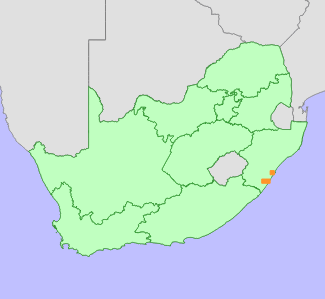|
Scientific Name | Geranium ornithopodioides Hilliard & B.L.Burtt |
Higher Classification | Dicotyledons |
Family | GERANIACEAE |
National Status |
Status and Criteria | Endangered B1ab(i,ii,iii,iv,v)+2ab(i,ii,iii,iv,v) |
Assessment Date | 2007/09/14 |
Assessor(s) | C.R. Scott-Shaw & L. von Staden |
Justification | Known from a few collections from two relatively disjunct areas in KwaZulu-Natal. Nevertheless, the range is extremely small: EOO 400 km², but could be as small as 25 km² if it proves to be locally extinct at an historical location that is extensively transformed. Based on herbarium collections, there are two to three locations, and there is a continuing decline in the habitat quality at present mainly due to dense alien plant invasions of riparian areas. |
Distribution |
Endemism | South African endemic |
Provincial distribution | KwaZulu-Natal |
Range | Pinetown and uMzinto districts, KwaZulu-Natal. |
Habitat and Ecology |
Major system | Terrestrial |
Major habitats | Moist Coast Hinterland Grassland, Scarp Forest |
Description | Scarp forest on sandstone, in forest margins or along streams, 300-700 m. |
Threats |
| This species is threatened by habitat disturbance as a result of urban development and severe infestations of the Molweni River valley by alien invasive plants in the Pinetown district (Scott-Shaw 1999).
Around uMzinto natural vegetation is extensively transformed by forestry plantations and sugarcane. River gorges are severely infested by alien invasive plants (C.R. Scott-Shaw pers. comm.). Ellesmere farm, where this species was last collected in 1981 (Hilliard and Burtt 1985), is entirely covered in plantations and this species is possibly locally extinct at this locality. Surveys are urgently required to determine whether this species still occurs in this area. |
Population |
There are three locations: Molweni River Valley (two locations — inside the boundaries of Kranzkloof Nature Reserve (habitat protected), and elsewhere in the valley (threatened by urban expansion and alien invaders); uMzinto district — one location. This area is excessively transformed by forestry plantations and sugarcane, and river valleys are invaded by aliens plants, and it needs to be confirmed whether any plants remain in this area.
|
Population trend | Decreasing |
Conservation |
| Kranzkloof Nature Reserve. |
Assessment History |
Taxon assessed |
Status and Criteria |
Citation/Red List version | | Geranium ornithopodioides Hilliard & B.L.Burtt | EN B1ab(i,ii,iii,iv,v) | Raimondo et al. (2009) | | Geranium ornithopodioides Hilliard & B.L.Burtt | EN | Scott-Shaw (1999) | |
Bibliography |
Hilliard, O.M. and Burtt, B.L. 1985. A revision of Geranium in Africa south of the Limpopo. Notes from the Royal Botanic Garden Edinburgh 42(2):171-225.
Raimondo, D., von Staden, L., Foden, W., Victor, J.E., Helme, N.A., Turner, R.C., Kamundi, D.A. and Manyama, P.A. 2009. Red List of South African Plants. Strelitzia 25. South African National Biodiversity Institute, Pretoria.
Scott-Shaw, C.R. 1999. Rare and threatened plants of KwaZulu-Natal and neighbouring regions. KwaZulu-Natal Nature Conservation Service, Pietermaritzburg.
|
Citation |
| Scott-Shaw, C.R. & von Staden, L. 2007. Geranium ornithopodioides Hilliard & B.L.Burtt. National Assessment: Red List of South African Plants version 2024.1. Accessed on 2025/11/07 |
 Comment on this assessment
Comment on this assessment


